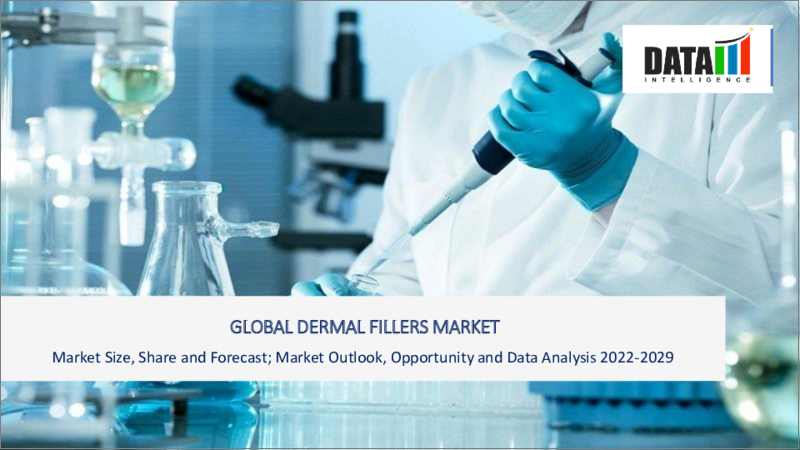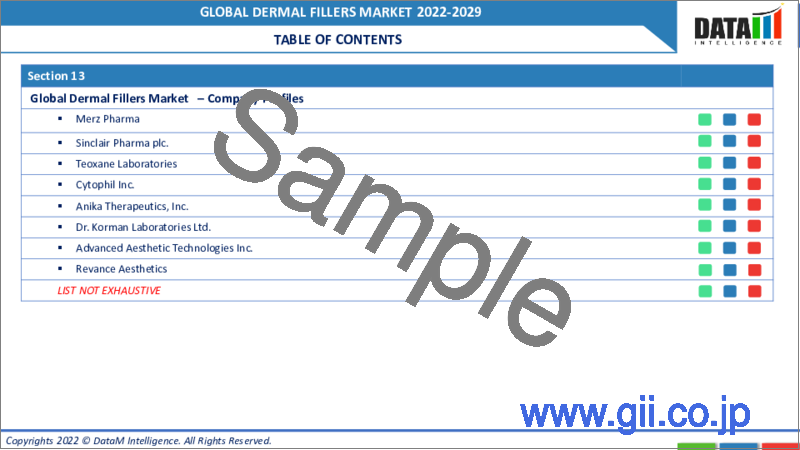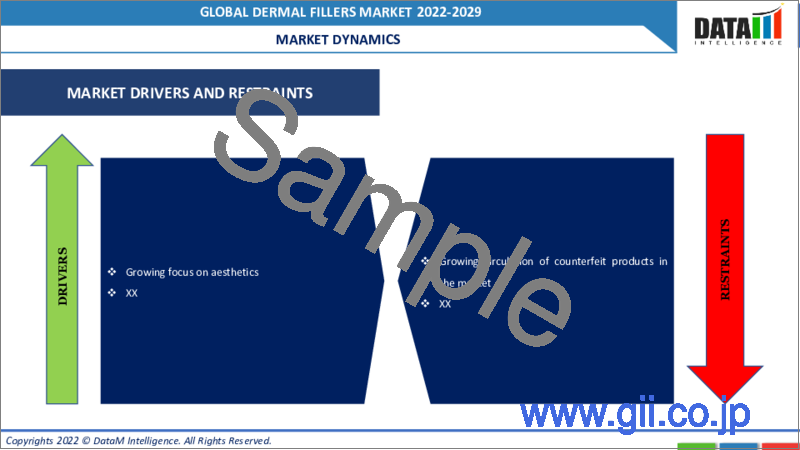|
|
市場調査レポート
商品コード
1146447
皮膚充填剤の世界市場-2022-2029Global Dermal Fillers Market - 2022-2029 |
||||||
|
● お客様のご希望に応じて、既存データの加工や未掲載情報(例:国別セグメント)の追加などの対応が可能です。 詳細はお問い合わせください。 |
|||||||
| 皮膚充填剤の世界市場-2022-2029 |
|
出版日: 2022年10月31日
発行: DataM Intelligence
ページ情報: 英文 200 Pages
納期: 約2営業日
|
- 全表示
- 概要
- 目次
市場の概要
皮膚充填剤の世界市場規模は、予測期間(2022-2029年)に11.10%のCAGRで成長するとされています。
皮膚充填剤は、服用することで顔のシワをふっくらとさせ、ラインをなめらかにする注射剤です。ヘルスケア専門家は一般的に、目、口、鼻の近くの領域に皮膚充填剤を注入します。この期待される美容処置は、通常、結果を直接もたらし、数カ月から数年間持続します。
市場力学
皮膚充填剤の世界市場は、技術の進歩、医療&美容外科における皮膚充填剤の採用拡大、患者の意識向上、美容施術への支出増加によって牽引されています。
医療&美容施術に対する一般市民の認知度の向上が市場成長を牽引
アンチエイジングに対する需要の高まりと、ソーシャルメディアにおける認知度の向上が、予測期間中の市場を牽引しています。2022年4月にAesthetic Surgery Journalに掲載された記事の通り、技術の進歩とソーシャルメディアの普及により、多様な美の基準や美的成果に対する認識が高まり、最終的に美と魅力の定義や治療目標の意識が広がっています。このような美容医療に対する顧客支出の劇的な増加は、逆に今後の美容医療市場に有望な展望を生み出しています。
調査対象の医師の約7割が、20代・30代のうちに美容医療を受けるべきと回答しています。また、美意識の高い女性では、30代で32%、40代で37%が「治療を受けるべき」と回答しています。
また、ソーシャルメディア時代において、皮膚充填剤市場は、顔のバランスを整えることで若年層を取り込むように発展しています。加齢による変化を修正するのではなく、若さを強調・維持することを目的としたこれらの治療には、あご形成、リッププランピング、リキッド鼻形成、ガミースマイル修正などが含まれます。
さらに、皮膚充填剤は、美の美的概念を満たすために顔を大きくするために使用され、従来の魅力的な顔を持つために特定の曲線、輪郭、寸法、および比率を満たすこと、または老化した顔の容積寸法とそれゆえの若さを改めることが指示されています。軟組織の生分解性フィラーを用いた顔面再生は、非永久的な注射装置であり、永久的な外科的美容処置と比較して、手頃で比較的安全な処置です。
皮膚充填剤の副作用が市場成長の妨げになる
しかし、注入部位の周囲に起こりがちな副作用は、赤み、腫れ、痛み、あざ、かゆみ、発疹など、すぐに現れるものです。稀な副作用としては、注入部位からのフィラーの漏れ、肉芽腫、感染症、フィラーに対する炎症反応、注入部位周辺の結節、ある部位から別の部位へのフィラーの移動、血管の損傷などが挙げられます。これらの副作用は、市場の成長を制限しています。
COVID-19の影響分析
COVID-19の登場は、世界の医療&美容市場にかなりの影響を与えました。2022年9月に発表された記事のように、化粧品の手順やエステティック介入は、必要性よりもむしろいくつかの豪華なライフスタイルです。COVIDの流行当初に行われた処置は大幅に減少しています。
しかし、社会的な距離の取り方により、人々は長時間ビデオ通話をするようになり、外見への不満が助長され、時には身体、特に顔に対する異形思考の進化を促し、その結果、エステや美容施術への需要が増加しました。
一方、SARS-CoV-2感染と関連するワクチンにより、過去に美容整形やエステティック施術を受けたことのある人に皮膚反応が見られるようになっています。さらに、災害や危機の後には通常、身体的・精神的な自己受容を向上させるための需要が増加しますが、COVID-19も例外ではありません。
2022年現在、COVID-19から回復し、ほぼすべての人がヘルスケアや美容施設を利用できるようになり、世界的に市場を牽引しています。
セグメント別分析
ヒアルロン酸(HA)セグメントは予測期間中(2022-2029年)に最も速いCAGRで成長すると予想されます。
ヒアルロン酸(HA)セグメントが最大の市場シェアを占める。注入可能なHAフィラーの人気急上昇は、流行中のステータスに上昇しています。それは、顔面皮膚壊死から神経眼科的後遺症まで、かつては稀だった異所性血管閉塞性損傷の発生率に付随する増加をもたらしています。
Molecules 2022に掲載された記事によると、皮膚充填剤は、HA注射用ゲルの売上が2005年から2020年の間に700%も急増して以来、20年間で人気の急上昇を示しているとのことです。2022年現在、美容フィラーの世界市場は、2030年までに65%という予測を登録しました。
化学的に架橋されたヒアルロン酸(HA、ヒアルロン酸)ゲル誘導体の出現は、外科、再生医療、薬理学における新しい治療用途をもたらし、生物医学の分野での新しい時代を示しています。しかし、ここ数年で最も著しい成長を遂げたのは、おそらく美容医療におけるハイドロコロイドHAベースの皮膚充填剤の利用であろう。これらの注射用HAジェルの爆発的な使用は、ジェルボリュームの偶発的な血管内注入に起因する微妙な虚血性組織梗塞の発生率の同時上昇をもたらし、フィラーによる血管閉塞を引き起こしているのです。
地域分析
皮膚充填剤の世界市場において北米地域が最大の市場シェアを占めている
北米は皮膚充填剤の市場を独占しており、予測期間中も同様の傾向を示すと予想されます。市場を牽引しているのは、高度なヘルスケアインフラなどの要因です。医療&美容の認知度が高まっていること、地域の主要プレーヤーが活発であること、同地域で製品が容易に入手可能であることなどがその要因です。
Molecules 2022に掲載された記事によると、米国だけでも年間約340万件の皮膚フィラー施術が行われており、フィラー製品の約80%はHAフィラーで占められているとのことです。このような美容用注射剤の需要の増加は、あらゆる年齢層および性別のグループにおいて形成外科手術が受け入れられつつあること、アクセスおよびマーケティングの向上、製品のコスト低下が原因であり、さらなる普及を促すと思われる競争の激化した市場を作り出しているのです。
また、市場プレイヤーは、事業拡大のために、コラボレーションや製品発売などの市場戦略を採用しています。例えば、2020年5月、AbbVieはAllerganを買収し、事業拡大を図りました。Allerganは、主に医療用美容、アイケア、中枢神経系、消化器系の4つの主要治療領域に特化したブランドと最高クラスの製品のポートフォリオを有しています。
競合情勢
皮膚充填剤市場は、地元企業や世界企業による適度な競争が存在する市場です。市場の成長に貢献している主な企業は、Allergan plc、Galderma、Merz Pharma、Sinclair Pharma plc、AQTIS Medical、Teoxane Laboratories、Cytophil Inc、Cynosure、 Dr. Korman Laboratories Ltd.、およびAdvanced Aesthetic Technologies Inc.などのメーカーです。主要プレイヤーは、製品の発売、買収、提携など、いくつかの成長戦略を採用しており、皮膚充填剤市場の世界の成長に寄与しています。
製品ポートフォリオ
JUVEDERM:ヒアルロン酸皮膚充填剤のJUVEDERMシリーズは、中程度から重度の顔のしわやひだを修正するものです。
世界の皮膚充填剤市場レポートでは、約40以上の市場データ表、45以上の図表、200ページ(概算)の範囲でのアクセスを提供することになります。
目次
第1章 市場調査手法とスコープ
- 調査手法
- 調査目的および調査範囲
第2章 市場の定義と概要
第3章 エグゼクティブサマリー
第4章 市場の力学
- 市場影響要因
- 促進要因
- 美的感覚への注目の高まり
- 非外科的な顔面矯正手術の需要
- 抑制要因
- 市場における偽造品の流通の増加
- ビジネスチャンス
- 影響分析
- 促進要因
第5章 産業分析
- ポーターのファイブフォース分析
- サプライチェーン分析
- 規制分析
第6章 COVID-19の分析
- COVID-19の市場分析
- COVID-19以前の市場シナリオ
- COVID-19の現在の市場シナリオ
- COVID-19の後、または将来のシナリオ
- COVID-19の中での価格ダイナミクス
- 需要-供給スペクトラム
- パンデミック時の市場に関連する政府の取り組み
- メーカーの戦略的取り組み
- まとめ
第7章 製品タイプ別
- 吸収性皮膚充填剤
- 非吸収性皮膚フィラー
第8章 材料別
- ヒアルロン酸(HA)
- ポリ乳酸(PLA)
- カルシウムハイドロキシアパタイト(CaH)
- ポリメチルメタクリレート(PMMA)
- コラーゲン
- その他
第9章 用途別
- フェイスライン矯正治療
- リップアップ
- 傷跡治療
- その他
第10章 エンドユーザー別
- 病院
- 外来手術センター
- 皮膚科クリニック
- その他
第11章 地域別
- 北米
- 米国
- カナダ
- メキシコ
- 欧州
- ドイツ
- 英国
- フランス
- イタリア
- スペイン
- その他欧州
- 南米
- ブラジル
- アルゼンチン
- その他の南米地域
- アジア太平洋地域
- 中国
- インド
- 日本
- オーストラリア
- その他アジア太平洋地域
- 中東・アフリカ地域
第12章 競合情勢
- 主な展開と戦略
- 企業シェア分析
- タイプ別ベンチマーク
第13章 企業プロファイル
- Allergan plc
- 企業概要
- 製品ポートフォリオと説明
- 主なハイライト
- 財務概要
- Galderma
- Merz Pharma
- Sinclair Pharma plc.
- AQTIS Medical
- Teoxane Laboratories
- Cytophil Inc.
- Cynosure
- Dr. Korman Laboratories Ltd.
- Advanced Aesthetic Technologies Inc.
第14章 皮膚充填剤の世界市場-DataM
Market Overview
The global dermal fillers market size was growing at a CAGR of 11.10% during the forecast period (2022-2029).
Dermal fillers are injections that will plump up wrinkles and smooth lines on the face after taking it. Healthcare professionals generally inject dermal fillers in the areas near the eyes, mouth and nose. This expected cosmetic procedure typically delivers results directly and lasts months or years.
Market Dynamics
The global dermal fillers market is driven by technological advancements, the growing adoption of dermal fillers in medical aesthetics surgeries, improving patient awareness, and rising expenditure on cosmetic procedures.
Increasing awareness of medical aesthetics procedures in public drives market growth
The rising demand for anti-aging and increasing social media awareness drive the market in the forecast period. As per the article published in the Aesthetic Surgery Journal in April 2022, technological advances and widespread use of social media have increased awareness of diverse standards of beauty and aesthetic outcomes, ultimately broadening definitions of beauty and attractiveness and the consciousness of treatment goals. This dramatic rise in customer spending on cosmetic procedures has, in turn, generated promising prospects for the aesthetic medicine market in the future.
Approximately 70% of surveyed physicians indicated that their patients should seek aesthetic treatments in their 20s and 30s. Among aesthetically conscious female survey respondents, 32% indicated that they should seek treatment in their 30s, and 37% reported that they should seek treatment in their 40s.
In addition, in the era of social media, the dermal fillers market has developed to include a younger demographic with facial re-balancing. These treatments, aimed at the enhancement and preservation of youth rather than correcting age-related changes, include chin augmentation, lip plumping, liquid rhinoplasty, and gummy smile modification.
Moreover, dermal fillers are deployed to increase the face to meet the aesthetic concept of beauty, dictating that certain curves, contours, dimensions, and ratios are fulfilled to have a conventionally attractive face or to reform volumetric dimensions and hence youth in the aging face. Facial regeneration using soft tissue biodegradable fillers, a non-permanent injectable device, provides an affordable and relatively safe procedure compared to permanent surgical cosmetic procedures.
The side effects of dermal fillers will hamper the growth of the market
However, the side effects which tend to occur around the injection site can be immediate, including redness, swelling, pain, bruising, itching and rash. Rare side effects include leakage of the filler through the injection site, granulomas, infection, inflammatory reaction to the filler, nodules around the injection site, movement of the filler from one area to another, and injury to blood vessels. These side effects limit the market growth.
COVID-19 Impact Analysis
The appearance of COVID-19 considerably impacted the global medical aesthetics market. As per the article published in September 2022, cosmetic procedures and esthetic interventions are some luxurious lifestyles rather than a necessity. There has been a substantial reduction in procedures performed at the beginning of the COVID pandemic.
However, social distancing has led people to spend long hours on video calls, which promoted appearance dissatisfaction and sometimes evolution of dysmorphic thoughts about the body, especially the face; this has resulted in increased demand for esthetic and cosmetic procedures.
On the other hand, the SARS-CoV-2 infection and associated vaccines have given rise to several dermatologic reactions in those individuals who have previously undergone cosmetic surgery or esthetic interventions. Moreover, the demand for improving physical and mental self-acceptance usually increases after any disaster or crisis, and COVID-19 is no exception.
As of 2022, the market is recovering from COVID-19, and almost all people can access healthcare and cosmetic facilities, which drives the market worldwide.
Segment Analysis
The Hyaluronic Acid (HA) segment is expected to grow at the fastest CAGR during the forecast period (2022-2029)
The Hyaluronic Acid (HA) segment accounts for the largest market share. The popularity surge of injectable HA fillers has risen to in-vogue status. It has brought a concomitant gain in the incidence of once-rare iatrogenic vaso-occlusive injuries, from disfiguring facial skin necrosis to disabling neuro-ophthalmological sequelae.
As per the article published in Molecules 2022, dermal fillers have witnessed a surge in popularity in the two decades since HA injectable gels sales boomed by 700% between 2005 and 2020. As of 2022, the global market for cosmetic fillers registered a forecast of 65% by 2030.
The advent of chemically cross-linked hyaluronic acid (HA, hyaluronan) gel derivatives has indicated a new era in the biomedical arena, yielding novel therapeutic applications in surgery and regenerative medicine, and pharmacology. However, it is perhaps the utilization of hydro colloidal HA-based dermal fillers in aesthetic medicine that has witnessed the most significant growth in the last years. The explosion in the use of these injectable HA gels has brought a simultaneous rise in the incidence of subtle ischemic tissue infarcts stemming from the accidental intravascular injection of gel boluses, resulting in filler-induced vascular occlusion.
Geographical Analysis
North America region holds the largest market share of the global dermal fillers market
North America dominates the market for dermal fillers and is anticipated to show a similar trend over the forecast period. The market is driven by factors such as advanced healthcare infrastructure. The increasing awareness of medical aesthetics procedures, active regional key players, and easy availability of products in the region.
As per the article published in Molecules 2022, in the United States alone, approximately 3.4 million dermal filler procedures are performed yearly, with HA fillers comprising nearly 80% of filler products. This increased demand for cosmetic injectables stems from the growing acceptance of plastic surgery procedures across all age and gender groups, increased accessibility and marketing, and decreased cost of products, creating an increasingly competitive market likely to favor further adoption.
In addition, the market players are adopting the market strategies such as collaboration and product launches to expand their business. For instance, in May 2020, AbbVie acquired Allergan to expand its business. Allergan has a portfolio of brands and best-class products mainly focused on four key therapeutic areas: medical aesthetics, eye care, central nervous system and gastroenterology.
Competitive Landscape
The dermal fillers market is a moderately competitive presence of local and global companies. Some of the key players contributing to the market's growth are Allergan plc, Galderma, Merz Pharma, Sinclair Pharma plc, AQTIS Medical, Teoxane Laboratories, Cytophil Inc., Cynosure, Dr. Korman Laboratories Ltd., and Advanced Aesthetic Technologies Inc., among others. The major players are adopting several growth strategies such as product launches, acquisitions, and collaborations, contributing to the growth of the dermal fillers market globally.
For instance,
- In January 2020, Anika Therapeutics, Inc., a global, integrated joint conservation and regenerative therapies company with products leveraging its proprietary hyaluronic acid technology platform, agreed to acquire Parcus Medical, a leading, privately-held sports medicine company, and Arthrosurface, a leading, privately-held provider of the joint surface and preservation solutions for active patients.
Allergan plc
Overview:
Allergan (part of Abbevie) is an American pharmaceutical company founded in 2013, and it produces products through advanced research to develop next-generation neuromodulator therapies and other treatments for neurological conditions.
Product Portfolio:
JUVEDERM: The JUVEDERM family of hyaluronic acid dermal fillers corrects moderate to severe facial wrinkles and folds.
The global dermal fillers market report would provide access to approximately 40+ market data tables, 45+ figures, and in the range of 200 (approximate) pages.
Table of Contents
1. Market Methodology and Scope
- 1.1. Research Methodology
- 1.2. Research Objective and Scope of the Report
2. Market Definition and Overview
3. Executive Summary
4. Market Dynamics
- 4.1. Market Impacting Factors
- 4.1.1. Drivers
- 4.1.1.1. Growing focus on aesthetics
- 4.1.1.2. Demand for non-surgical procedures for facial correction
- 4.1.2. Restraints:
- 4.1.2.1. Growing circulation of counterfeit products in the market
- 4.1.3. Opportunity
- 4.1.4. Impact Analysis
- 4.1.1. Drivers
5. Industry Analysis
- 5.1. Porter's Five Forces Analysis
- 5.2. Supply Chain Analysis
- 5.3. Regulatory Analysis
6. COVID-19 Analysis
- 6.1. Analysis of Covid-19 on the Market
- 6.1.1. Before COVID-19 Market Scenario
- 6.1.2. Present COVID-19 Market Scenario
- 6.1.3. After COVID-19 or Future Scenario
- 6.2. Pricing Dynamics Amid Covid-19
- 6.3. Demand-Supply Spectrum
- 6.4. Government Initiatives Related to the Market During Pandemic
- 6.5. Manufacturer's Strategic Initiatives
- 6.6. Conclusion
7. By Product Type
- 7.1. Introduction
- 7.1.1. Market Size Analysis, and Y-o-Y Growth Analysis (%), By Product Type
- 7.1.2. Market Attractiveness Index, By Product Type
- 7.2. Absorbable Dermal Fillers*
- 7.2.1. Introduction
- 7.2.2. Market Size Analysis, US$ Million, 2020-2029 and Y-o-Y Growth Analysis (%), 2021-2029
- 7.3. Non-Absorbable Dermal Fillers
8. By Material
- 8.1. Introduction
- 8.1.1. Market Size Analysis, and Y-o-Y Growth Analysis (%), By Material
- 8.1.2. Market Attractiveness Index, By Material
- 8.2. Hyaluronic Acid (HA)*
- 8.2.1. Introduction
- 8.2.2. Market Size Analysis, US$ Million, 2020-2029 and Y-o-Y Growth Analysis (%), 2021-2029
- 8.3. Poly-L-Lactic Acid (PLA)
- 8.4. Calcium Hydroxylapatite (CaH)
- 8.5. Polymethylmethacrylate (PMMA)
- 8.6. Collagen
- 8.7. Others
9. By Application
- 9.1. Introduction
- 9.1.1. Market Size Analysis, and Y-o-Y Growth Analysis (%), By Application
- 9.1.2. Market Attractiveness Index, By Application
- 9.2. Facial Line Correction Treatment*
- 9.2.1. Introduction
- 9.2.2. Market Size Analysis, US$ Million, 2020-2029 and Y-o-Y Growth Analysis (%), 2021-2029
- 9.3. Lip Enhancement
- 9.4. Scar Treatment
- 9.5. Others
10. By End User
- 10.1. Introduction
- 10.1.1. Market Size Analysis, and Y-o-Y Growth Analysis (%), By End User
- 10.1.2. Market Attractiveness Index, By End User
- 10.2. Hospitals*
- 10.2.1. Introduction
- 10.2.2. Market Size Analysis, US$ Million, 2020-2029 and Y-o-Y Growth Analysis (%), 2021-2029
- 10.3. Ambulatory Surgical Centers
- 10.4. Dermatology Clinics
- 10.5. Others
11. By Region
- 11.1. Introduction
- 11.1.1. Market Size Analysis, US$ Million, 2020-2029 and Y-o-Y Growth Analysis (%), 2021-2029, By Region
- 11.1.2. Market Attractiveness Index, By Region
- 11.2. North America
- 11.2.1. Introduction
- 11.2.2. Key Region-Specific Dynamics
- 11.2.3. Market Size Analysis, and Y-o-Y Growth Analysis (%), By Product Type
- 11.2.4. Market Size Analysis, and Y-o-Y Growth Analysis (%), By Material
- 11.2.5. Market Size Analysis, and Y-o-Y Growth Analysis (%), By Application
- 11.2.6. Market Size Analysis, and Y-o-Y Growth Analysis (%), By End User
- 11.2.7. Market Size Analysis, and Y-o-Y Growth Analysis (%), By Country
- 11.2.7.1. The U.S.
- 11.2.7.2. Canada
- 11.2.7.3. Mexico
- 11.3. Europe
- 11.3.1. Introduction
- 11.3.2. Key Region-Specific Dynamics
- 11.3.3. Market Size Analysis, and Y-o-Y Growth Analysis (%), By Product Type
- 11.3.4. Market Size Analysis, and Y-o-Y Growth Analysis (%), By Material
- 11.3.5. Market Size Analysis, and Y-o-Y Growth Analysis (%), By Application
- 11.3.6. Market Size Analysis, and Y-o-Y Growth Analysis (%), By End User
- 11.3.7. Market Size Analysis, and Y-o-Y Growth Analysis (%), By Country
- 11.3.7.1. Germany
- 11.3.7.2. U.K.
- 11.3.7.3. France
- 11.3.7.4. Italy
- 11.3.7.5. Spain
- 11.3.7.6. Rest of Europe
- 11.4. South America
- 11.4.1. Introduction
- 11.4.2. Key Region-Specific Dynamics
- 11.4.3. Market Size Analysis, and Y-o-Y Growth Analysis (%), By Product Type
- 11.4.4. Market Size Analysis, and Y-o-Y Growth Analysis (%), By Material
- 11.4.5. Market Size Analysis, and Y-o-Y Growth Analysis (%), By Application
- 11.4.6. Market Size Analysis, and Y-o-Y Growth Analysis (%), By End User
- 11.4.7. Market Size Analysis, and Y-o-Y Growth Analysis (%), By Country
- 11.4.7.1. Brazil
- 11.4.7.2. Argentina
- 11.4.7.3. Rest of South America
- 11.5. Asia Pacific
- 11.5.1. Introduction
- 11.5.2. Key Region-Specific Dynamics
- 11.5.3. Market Size Analysis, and Y-o-Y Growth Analysis (%), By Product Type
- 11.5.4. Market Size Analysis, and Y-o-Y Growth Analysis (%), By Material
- 11.5.5. Market Size Analysis, and Y-o-Y Growth Analysis (%), By Application
- 11.5.6. Market Size Analysis, and Y-o-Y Growth Analysis (%), By End User
- 11.5.7. Market Size Analysis, and Y-o-Y Growth Analysis (%), By Country
- 11.5.7.1. China
- 11.5.7.2. India
- 11.5.7.3. Japan
- 11.5.7.4. Australia
- 11.5.7.5. Rest of Asia Pacific
- 11.6. Middle East and Africa
- 11.6.1. Introduction
- 11.6.2. Key Region-Specific Dynamics
- 11.6.3. Market Size Analysis, and Y-o-Y Growth Analysis (%), By Product Type
- 11.6.4. Market Size Analysis, and Y-o-Y Growth Analysis (%), By Material
- 11.6.5. Market Size Analysis, and Y-o-Y Growth Analysis (%), By Application
- 11.6.6. Market Size Analysis, and Y-o-Y Growth Analysis (%), By End User
12. Competitive Landscape
- 12.1. Key Developments and Strategies
- 12.2. Company Share Analysis
- 12.3. Type Benchmarking
13. Company Profiles
- 13.1. Allergan plc*
- 13.1.1. Company Overview
- 13.1.2. Product Portfolio and Description
- 13.1.3. Key Highlights
- 13.1.4. Financial Overview
- 13.2. Galderma
- 13.3. Merz Pharma
- 13.4. Sinclair Pharma plc.
- 13.5. AQTIS Medical
- 13.6. Teoxane Laboratories
- 13.7. Cytophil Inc.
- 13.8. Cynosure
- 13.9. Dr. Korman Laboratories Ltd.
- 13.10. Advanced Aesthetic Technologies Inc.
LIST NOT EXHAUSTIVE
14. Global Dermal Fillers Market - DataM
- 14.1. Appendix
- 14.2. About Us and Services
- 14.3. Contact Us




